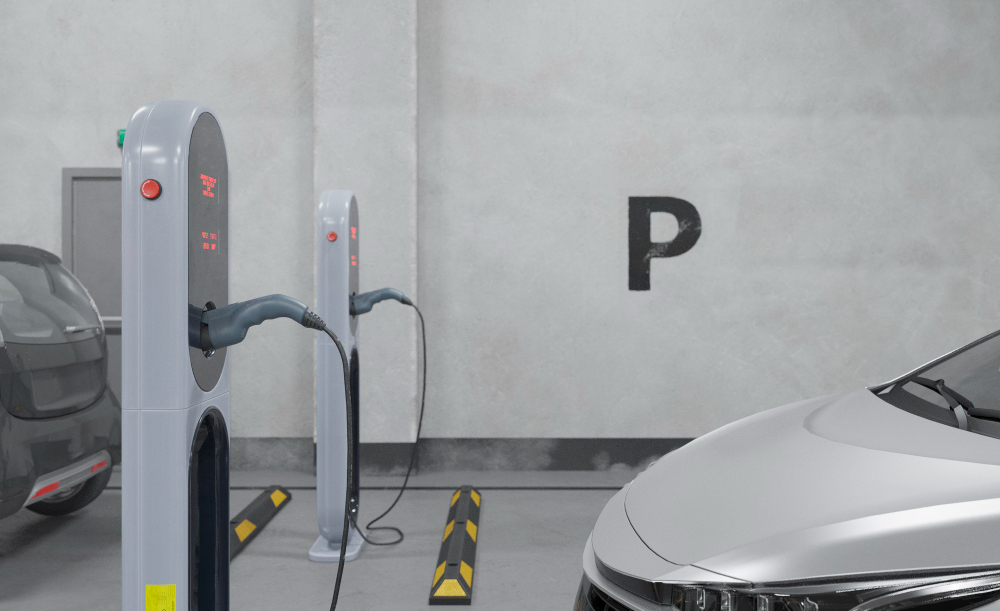Electric vehicles (EVs) are gaining popularity as a sustainable transportation option. Having a personal EV charging station is becoming a practical necessity for many EV owners. A steel garage is an excellent location for such an installation as it offers durability, security, and protection for both your vehicle and the charging equipment.
If you are considering adding an EV charging station to your steel garage, this comprehensive guide will walk you through the steps, from planning and preparation to installation and safety measures.
Why Install an EV Charging Station in Your Steel Garage?
Having a dedicated EV charging station in your steel garage offers unparalleled convenience for modern EV owners. You no longer have to depend on the availability of public charging stations, which can be time-consuming and inconvenient. Instead, you can charge your vehicle overnight or at any time that suits your schedule, ensuring that your EV is always ready to go. Additionally, opting for a Level 2 charger at home provides a faster and more efficient charging experience compared to a standard 120-volt wall outlet. With a Level 2 charger, you can fully charge your vehicle in a matter of hours, making it ideal for those with busy lifestyles or frequent commutes.
Steel garages are particularly well-suited for housing EV charging stations due to their durability and protective properties. Unlike open carports or outdoor setups, the enclosed nature of a steel garage shields the charging equipment from environmental factors such as rain, wind, and snow, which can cause wear and tear over time. This protection extends the lifespan of both the charger and your vehicle’s charging components. Furthermore, the robust steel construction provides added security, minimizing the risk of theft or vandalism of your charging equipment.
Beyond convenience and protection, installing an EV charger in your steel garage can also lead to long-term cost savings. Charging at home is generally more affordable than using public charging stations, especially if you take advantage of off-peak electricity rates offered by many utility companies. Moreover, having a home charging station can increase the overall value of your property, making it a desirable feature for potential buyers in the future as EV adoption continues to grow. By combining practicality, cost-efficiency, and enhanced security, a steel garage equipped with an EV charging station is a forward-thinking investment that aligns with the needs of eco-conscious homeowners.
Step 1: Assess Your Charging Needs
Understand Charging Levels
There are three primary levels of EV charging:
- Level 1 (120V)
Uses a standard household outlet and is the slowest option. Suitable for occasional use or overnight charging.
- Level 2 (240V)
Requires specialized equipment and is significantly faster than Level 1. Ideal for most home installations.
- Level 3 (DC Fast Charging)
Not typically installed in residential settings due to high costs and power requirements.
For most homeowners, a Level 2 charger strikes the perfect balance between speed and affordability.
Check Your Vehicle’s Charging Requirements
Consult your EV manufacturer’s specifications to determine the compatible charging equipment and power requirements. Ensure the charger you select meets your vehicle’s standards.
Step 2: Plan Your Installation
Evaluate Your Garage’s Electrical Capacity
Your steel garage must have sufficient electrical capacity to support an EV charger. Hire a licensed electrician to assess your home’s electrical panel and determine whether an upgrade is needed. A Level 2 charger typically requires a dedicated 240V circuit with a 40-amp breaker.
Choose the Charger Location
Select a location within your steel garage that is easily accessible for your vehicle. Ensure there is enough clearance around the charger and that the charging cable can comfortably reach the EV’s charging port.
Decide on Hardwired vs. Plug-In Installation
- Hardwired Chargers
Permanently installed and connected directly to the electrical system. Suitable for outdoor or semi-permanent setups.
- Plug-In Chargers
Connected to a 240V outlet and offer flexibility for relocation.
Step 3: Obtain Necessary Permits
Installing an EV charging station in your steel garage often involves navigating local regulations and permit requirements. Many municipalities mandate permits for electrical work, particularly when installing Level 2 chargers that require a dedicated 240-volt circuit. The permitting process ensures that the installation meets safety standards and complies with local building codes. Before starting your project, contact your local building authority or permitting office to verify the specific requirements in your area. Some locations may also require inspections before and after the installation to confirm the work is done correctly and safely.
Failing to secure the necessary permits can lead to a host of problems down the line. Homeowner’s insurance policies often require documented proof of permitted work to cover any damages related to electrical installations. Without proper permits, you may face complications with insurance claims or even policy cancellations. Additionally, unpermitted installations can result in fines, legal issues, or complications if you decide to sell your property in the future. Taking the time to understand and comply with permit requirements ensures a smooth, trouble-free installation and provides peace of mind knowing your EV charging station is safe and up to code.
Step 4: Prepare the Site
Upgrade Your Electrical Panel (If Needed)
If your home’s electrical panel lacks capacity for the charger, an upgrade may be required. This involves replacing the panel with one that can handle higher amperage, ensuring safe and efficient operation.
Install a 240V Outlet or Dedicated Circuit
Work with a licensed electrician to install a 240V outlet or dedicated circuit in the chosen location. The electrician will ensure the wiring meets safety standards and local codes.
Step 5: Install the Charger
Mount the Charger
Follow the manufacturer’s instructions to mount the charging unit on your garage wall. Use appropriate mounting hardware for your steel structure to ensure stability.
Connect to Power
For hardwired chargers, the electrician will connect the unit directly to the electrical system. For plug-in chargers, simply plug the unit into the 240V outlet.
Test the Installation
Once the charger is installed, test it to ensure it functions correctly. Verify that it delivers the appropriate voltage and amperage to your EV.
Step 6: Implement Safety Measures
Install Ground Fault Protection
Ground fault protection devices help prevent electrical shocks and enhance safety. Many modern chargers come with built-in ground fault protection.
Weatherproofing
If your garage is not fully enclosed, consider weatherproofing the charging equipment. Use protective covers and ensure all connections are sealed to prevent water or dust intrusion.
Fire Safety
Ensure that your garage is equipped with a fire extinguisher rated for electrical fires. Regularly inspect the charging equipment for signs of wear or damage.
Step 7: Optimize Charging Efficiency
Schedule Charging Times
Many EV chargers allow you to schedule charging sessions during off-peak hours, saving on electricity costs. Check if your utility provider offers special rates for EV charging.
Monitor Energy Usage
Some chargers include apps or displays that track energy consumption. Use this data to optimize your charging habits and reduce costs.
Step 8: Maintain Your Charging Station
Regular Inspections
Periodically inspect the charger, cables, and connectors for signs of wear or damage. Address any issues promptly to prevent accidents.
Clean the Equipment
Keep the charging station clean and free of debris. Use a dry cloth to wipe down the unit and ensure the charging port remains unobstructed.
Update Firmware
If your charger is equipped with smart features, check for firmware updates from the manufacturer. These updates may improve performance or add new features.
Benefits of Installing a Charging Station in Your Steel Garage
Convenience
Having a personal EV charger means you can charge your vehicle on your schedule, eliminating the need to visit public charging stations.
Cost Savings
Charging at home is often cheaper than using public stations, especially if you take advantage of off-peak electricity rates.
Increased Property Value
Installing an EV charger can increase your home’s appeal to potential buyers, particularly as EV adoption continues to rise.
Conclusion
Installing an EV charging station in your steel garage is a practical and forward-thinking investment. Following this guide so you can ensure a safe and efficient installation that enhances the usability of your garage and supports your transition to sustainable transportation. As long as you plan properly and seek professional assistance, your EV charging station will serve as a reliable and convenient solution for years to come.

